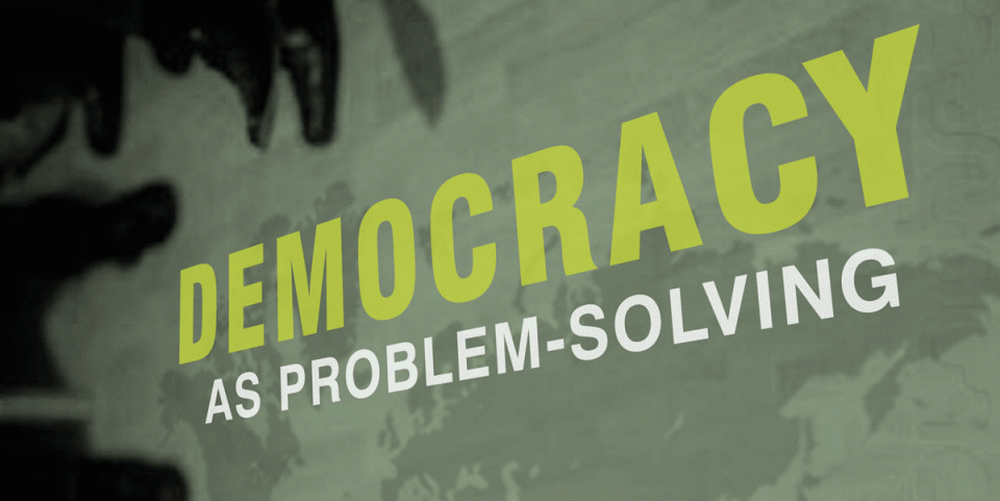
Near the end of his 2008 book Democracy as Problem Solving, Xavier de Souza Briggs reflects:
Many ideas about making democracy work stop at asking the question: how might we improve the relationship between citizens and their government? That is an important question, but I have pursued a broader one: how might we improve the relationships among citizens, government, and private parties (including businesses and unelected interest-group advocates and philanthropies that bring vital resources and capacity) in relation to important public problems. (p. 297)
Briggs frames a question of agency: how to undertake and achieve the real work of making communities function better for their members.
In our work at Incandescent, we think of human enterprise – people pursuing objectives – as spanning a nested set of levels, starting with the individual, widening to the “small we” of a group of people pursuing a shared goal, then institutions, then the more complex constellations of actors that Briggs writes about, stretching all the way up to the “very big we” of humanity over the long arc of time. As the scale of action moves up along this spectrum, we see the swinging of a kind of pendulum, back and forth, from tightly to loosely integrated agents.
An individual is the paradigm case of a tightly-integrated agent – there’s an actual person acting on the basis of his or her objectives and beliefs. Looking at the “small we” made up of a group of people acting together, each knowingly in collaboration with the others, agency is more loosely integrated. We can talk about a rock band, a basketball team or a trio of co-authors wanting X or doing Y, but underneath there is the jostling of separate people on their distinct trajectories. Up at the level of an institution, the integration swings back toward the tighter end, where the institution’s hierarchy, rules and status as a legal entity clarifies its “desires” and its voice.
Briggs’ subjects represent a paradigm case of loosely-integrated agents: broad coalitions of actors, across sectors, trying – or failing – to find common cause on a problem like economic development in Pittsburgh or the redevelopment of slums in Mumbai. His case studies teach us about what matters at the loosely-integrated end of the continuum of agency, where setting and keeping an agenda is difficult enough, and acting effectively on behalf of an agenda is still more difficult.
Let’s go with Briggs to Pittsburgh (chapter 7), where he examines a case study that we might term “organizing in response to a slow catastrophe.” Pittsburgh’s population fell by nearly half between 1960 and 2000, in the context of a sustained economic shift that reached its nadir in the early to mid eighties, during which the base of manufacturing jobs shrank by more than forty percent in a seven-year period. Briggs shows us, intricately, the dynamics of a community assembling the capacity to act. He guides us through the history of the Allegheny Conference on Community Development and its affiliates, as they chart a course to restore economic vitality in the region.
The Allegheny Conference was one of the few institutions positioned to be a convener and integrator, as it repositioned itself to catalyze change at a regional level. At an early stage in this transformation, “the litmus-test project under this new approach was to create a regional asset district” that could draw funds from across the region to support civic facilities such as the zoo, parks, arts organizations and the like (155). This project was a litmus test not just because having a funding mechanism — and a County Executive strong enough to administer that mechanism — was required to achieve an economic outcome, but also because the project provided proof that collective action could work. When cohesion isn’t viewed as a credible path, parties whose capabilities might add up to achieving critical results won’t actually come together to get the big things done.
Briggs shows us the “micro” gears that must interlock for “macro” movement to take place. He brings us into the boardroom to get a view of the mechanics by which specific individuals got positioned to bring disparate entities into a common orbit. For example, the steps by which Rick Stafford accumulated a range of management hats beyond his role as Executive Director of the Allegheny Conference, such as becoming (simultaneously) the staff director of the Pennsylvania Economy League, then taking the reins of the Pittsburgh Regional Alliance. The details might at certain moments feel tedious, until one reminds oneself that this succession of small moves is precisely how bigger change happens.
I have written before about what it means to have strategic clarity:
Commitment to a destination and to core concepts that shape the choices for how to get there
We see in the Pittsburgh case the importance of a handful of concepts, such as the shift from chasing prospective large employers to cultivating companies already in the Pittsburgh ecosystem. Such concepts, however, are only meaningful insofar as they are translated into many specific, consistent choices. The looser the “we,” the more difficult it is to build mechanisms to consistently translate core concepts into choices. Briggs shows us these mechanisms at work, painting a picture of the roles played by:
- Aggregation and integration: for example, the umbrella of the Greater Pittsburgh Nonprofit Partnership, bringing together more than 250 non-profits into an effective body that coordinates with and exerts pressure on other actors
- Attaining resources to fuel a strategy: for example, the Southwestern Pennsylvania Commission, with its billion dollars per year of infrastructure funds
- Transformation of specific institutions: for example, SPC’s move beyond a “divvy-up-the-dollars-by-county approach to governance” after selection of a new chief executive
Through the lens of these mechanisms, we see not just the conceptualization but the engineering of collective action.
Briggs calls the sum total of these concepts and mechanisms, relationships and institutions “civic capacity.” He writes:
Civic capacity might be thought of as the extent to which the sectors that make up a community are (1) capable of collective action on public problems (the resource dimension), given the norms and institutional arenas for local action; and (2) choose to apply such capability (the dimension of effort, will and choice, or “agency”). (13)
I believe this examination of civic capacity sheds light not just on how to solve problems in a democratic way at the level of regions or cities, but how we govern the republic of our selves. While individuals seem tightly integrated as agents compared to the kind of regional “actors” Briggs writes about, both kinds of agents can be understood along a continuum of degrees of integration. An individual can be seen as a kind of sustained coalition of many disparate aims, models and habits. In the morning staff meeting, one checks off items completed; in the afternoon customer visit, one trots out the routines that have worked before; on the evening drive home, one’s mind rehearses a familiar set of hopes or resentments. This might or might not add up to efficacy along the dimensions that matter most.
Achieving effectiveness as a person, as a team or as a company is very much like the work that Briggs describes taking place in Pittsburgh. Disparate concerns need to be brought under the heading of a small number of core concepts that enable those many particulars to be navigated coherently. Patterns of organization need to be built that focus attention where it is needed, and stitch many things done in many contexts into the steady, exponential path toward progress.
Democracy as Problem Solving is an important book, a portrait of the art of building capacity to do what’s important and what’s difficult. Briggs deserves E. M. Forster’s “two cheers” for showing us the complex, messy, many-faceted path to effective collective action: a daunting path, to be sure, but often the best path we have.



